By Joshua Bray
Next Lesson - The Eye
Abstract
- The oral cavity is bounded by: the teeth; buccinator muscles; hard and soft palate; tongue and mylohyoids; and the palatoglossal and palatopharyngeal arches.
- The roof of the mouth is made up of the hard palate anteriorly and soft palate posteriorly.
- The tonsils are aggregates of lymphoid tissue and form an arrangement called Waldeyer’s ring.
- Tonsillitis is most commonly viral, but can also be caused by the bacterium Streptococcus pyogenes.
- The adult has 32 permanent teeth: 8 incisors, 4 canines, 8 pre-molars and 12 molars.
- Each tooth has a crown, a neck, and a root.
- Poor oral hygiene can lead to dental caries and gum disease.
- The tongue is a highly mobile structure due to the many actions of its intrinsic and extrinsic muscles.
- The tongue receives sensory innervation from cranial nerves V, VII and IX.
- Most of the muscles of the tongue are innervated by cranial nerve XII.
- There are 3 pairs of salivary glands: parotid, submandibular and sublingual.
- The pharynx is split into 3 areas: nasopharynx, oropharynx, and laryngopharynx.
- The pharynx has longitudinal and circular muscles, most of which are innervated by cranial nerve X.
- Swallowing is a complex mechanism which has 3 phases: oral phase, pharyngeal phase, and oesophageal phase.
Core
The primary function of the mouth is to act as a receptacle for food and drink, and to initiate digestion.
The opening to the mouth is known as the oral fissure. Immediately posterior to this is the vestibule, which is a slit-like space between the lips and the gums and teeth. Beyond the teeth is the oral cavity proper.
The boundaries of the oral cavity proper are:
- Anterior boundary – Teeth
- Lateral walls – Buccinator muscles
- Roof – Hard and soft palate
- Floor – Tongue and mylohyoid muscles
- Posterior boundary – Palatoglossal and palatopharyngeal arches
The palate forms the roof of the oral cavity. The anterior 2/3 of the palate is made of bone and is called the hard palate. The soft palate makes up the posterior 1/3 of the palate; it is moveable and made up of soft tissue. The muscles of the soft palate are innervated by the vagus nerve (CN X). Suspended from the soft palate is the uvula, which has roles in speech, lubrication of the mouth and stimulation of the gag reflex.
The soft palate is continuous with the wall of the pharynx and extends laterally to form two arches: the palatoglossal arch (anteriorly) and palatopharyngeal arch (posteriorly). The space between these arches is called the palatine fossa, which accommodates the palatine tonsils.

Diagram - Basic anatomy of the mouth
Public Domain Source [Public domain]
The tonsils are aggregations of lymphoid tissue found within the oral cavity and nasopharynx. They are therefore part of the immune system and specifically protect against ingested and inhaled pathogens.
There are 6 tonsils, which form an arrangement called Waldeyer’s ring:
- Lingual Tonsil – located within the submucosa of the posterior 1/3 of the tongue.
- Palatine Tonsils (x2) – located within the palatine fossae.
- Tubal Tonsils (x2) – located in the lateral walls of the nasopharynx, near the opening of the Eustachian tube.
- Pharyngeal Tonsil (adenoids) – located in the roof of the nasopharynx.
The pharynx and tonsils can become inflamed due to infection, resulting in pharyngitis and/or tonsillitis respectively. Most cases of tonsillitis are viral, however, it can also be caused by the bacterium Streptococcus pyogenes, which produces a more severe infection. The likelihood of a tonsillitis being bacterial in nature can be estimated using the Centor criteria or FeverPAIN score. Viral cases are managed conservatively whereas bacterial tonsillitis is treated with an antibiotic such as penicillin V. For more information, check out our article on Streptococci.
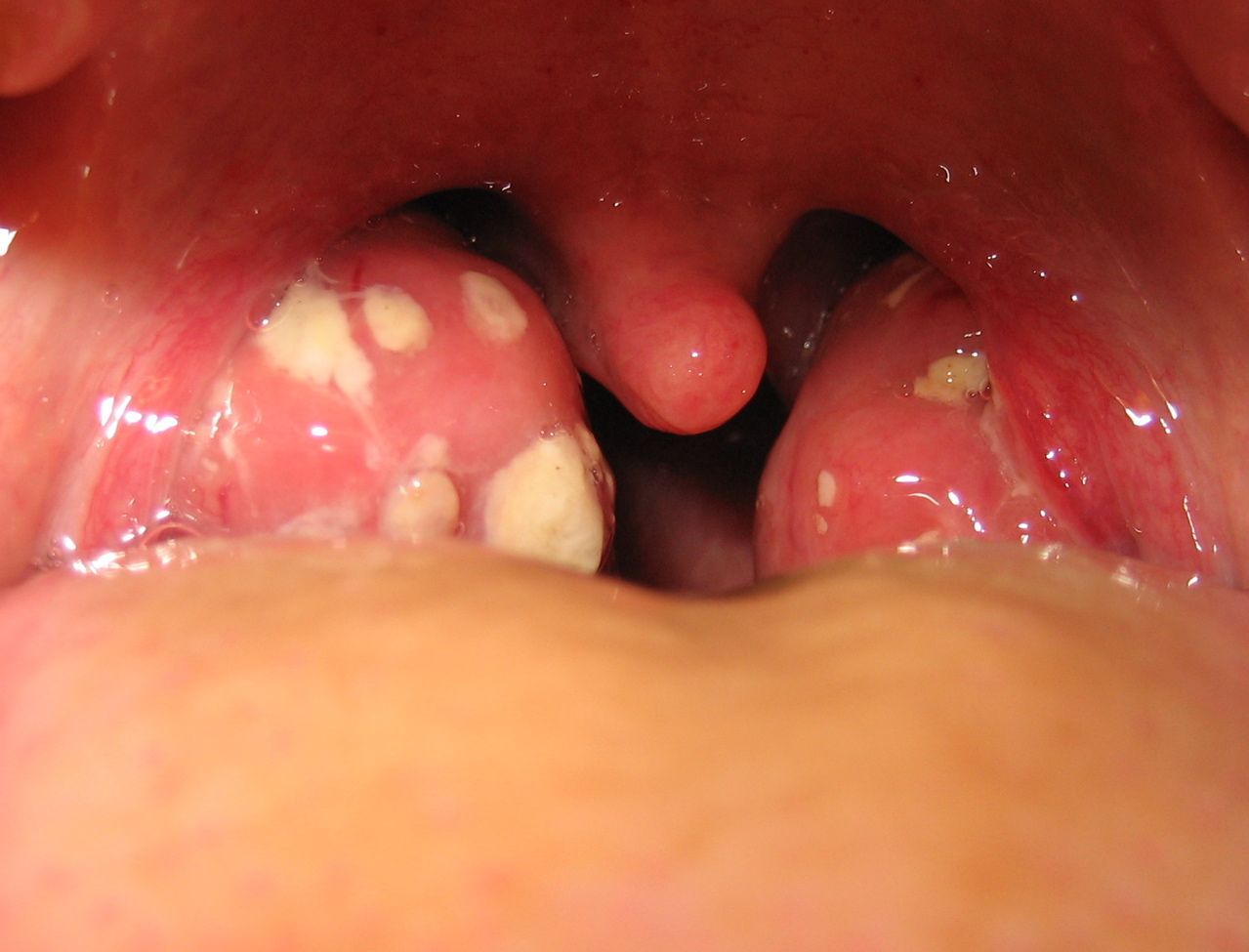
Image - Inflamed palatine tonsils with a purulent exudate
Public Domain Source by Michaelbladon [Public domain]
The primary function of the teeth is mastication (chewing), which increases the surface area of food for digestive enzymes to act on and enable bolus formation. The teeth also play a role in articulation of speech.
Humans have 2 sets of teeth during their lifetime: deciduous (primary) and permanent (secondary). Children have 20 deciduous teeth, which shed between the ages of 6-12 years as the permanent teeth erupt and take their place. Adults normally have 32 permanent teeth, most of which erupt by aged 12 years. The 3rd molars (wisdom teeth) can take up to the age of 25 to erupt and may not even be present in some individuals.
Teeth are classified by the characteristics and function:
- Incisors (8) – located centrally, these thin knife-like teeth act to cut food and break off food in the initial bite.
- Canines (4) – these cone-shaped teeth are designed for shearing food.
- Pre-molars (8) – these have 2 cusps and a flatter surface for mashing and grinding.
- Molars (12) – these back teeth have 3 or more cusps and a flat surface for mashing and grinding.
Each tooth has a crown, a neck and a root. The crown is the externally visible part of the tooth which projects from the gingiva. The neck is the region between the crown and root. The root is fixed in the tooth socket by some connective tissue called the periodontium. The majority of the tooth is composed of dentine. The crown is lined with enamel (the hardest substance in the body!) and the root is lined with cement. The root canal transmits nerves and blood vessels.
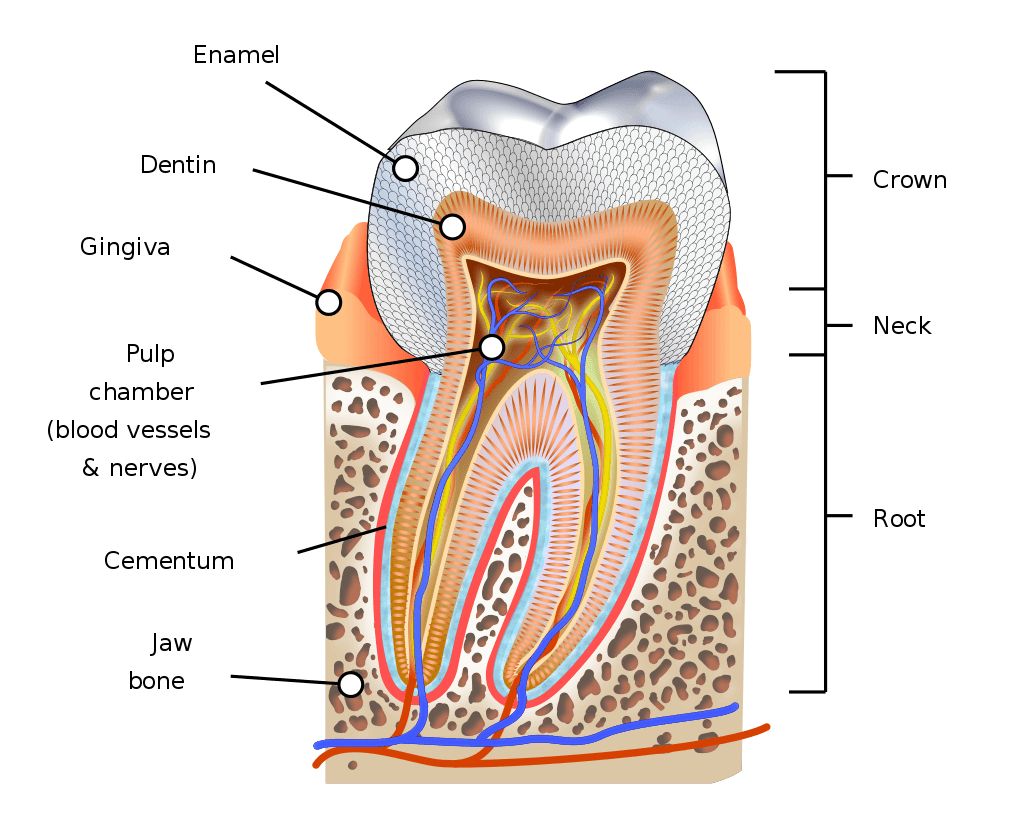
Diagram - Anatomy of the tooth
Creative commons source by KDS4444 [CC BY-SA 4.0 (https://creativecommons.org/licenses/by-sa/4.0)]
Bacteria in the oral cavity produce acid and enzymes which may break down the enamel of the tooth, resulting in dental caries. Left untreated, this decay can extend into the pulp cavity resulting in infection and inflammation of the pulp, which presents with considerable toothache. This could eventually lead to abscess formation and loss of the tooth. Treatment involves removal of the decayed tissue and replacement with a prosthetic filling.
Bacterial deposits in the mouth can also irritate the gums, leading to gingivitis. This presents with swollen, red gums which are tender and bleed easily. Gingivitis can potentially progress to periodontitis and abscess formation. Management involves maintaining good oral hygiene (including flossing) and chlorhexidine mouthwashes can also be helpful. The dentist or hygienist can also offer more specialist cleaning treatments.
The tongue is a very mobile, muscular organ which occupies most of the oral cavity at rest. It has important roles in taste, speech and swallowing.
The tongue is lined with mucosa, which contains projections called papillae. The papillae increase the surface area of the tongue and are covered with taste buds.
The tongue is anchored to the floor of the mouth via the lingual frenulum.
Muscles of the tongue are grouped as either intrinsic or extrinsic:
- Intrinsic – there are 4 pairs of intrinsic muscles which act to alter the shape of the tongue.
- Superior longitudinal
- Inferior longitudinal
- Transverse
- Vertical
- Extrinsic – these muscles connect the tongue to surrounding structures and act to alter the position of the tongue.
- Genioglossus – important in protruding the tongue.
- Hyoglossus
- Styloglossus
- Palatoglossus
Most of the muscles of the tongue are innervated by the hypoglossal nerve (CN XII). The exception is palatoglossus, which is innervated by the vagus nerve (CN X).
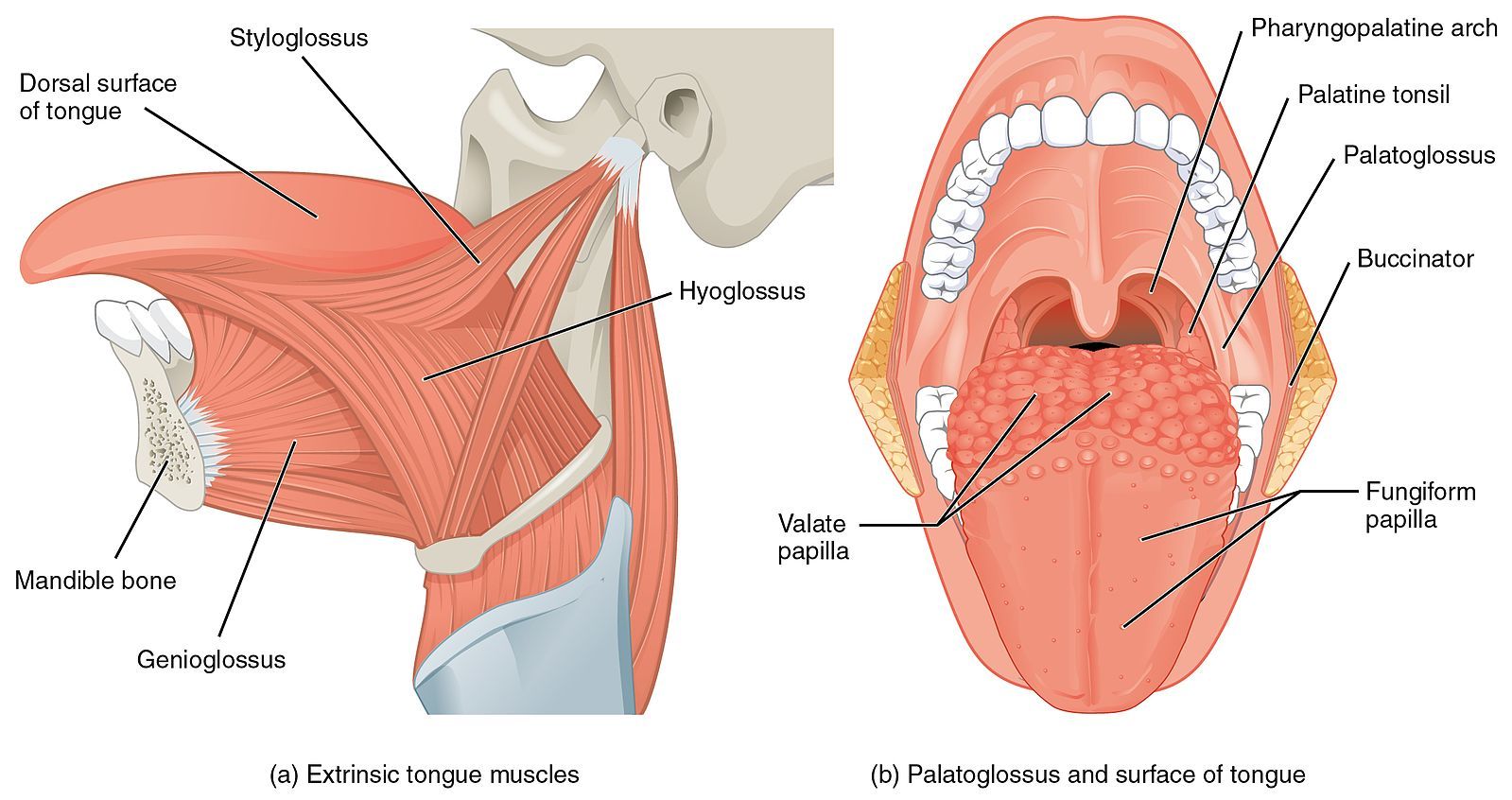
Diagram - Muscles of the tongue
Creative commons source by OpenStax [CC BY-SA 4.0 (https://creativecommons.org/licenses/by-sa/4.0)]
The special sensory innervation of the tongue (i.e. taste) is the following:
- Anterior 2/3 – chorda tympani, a branch of the facial nerve (CN VII)
- Posterior 1/3 – glossopharyngeal nerve (CN IX)
The general sensory innervation of the tongue is:
- Anterior 2/3 – lingual nerve, a branch of the mandibular division of the trigeminal nerve (CN Vc)
- Posterior 1/3 – glossopharyngeal nerve (CN IX)
The salivary glands are 3 pairs of exocrine glands whose ducts open into the oral cavity. They produce saliva, which has important roles in digestion, lubrication, bolus formation and innate immunity.
The 3 pairs of salivary glands are:
- Parotid Glands – the largest of the salivary glands. They are bounded by the zygomatic arch, mandible, sternocleidomastoid and masseter muscle. Its secretions enter the oral cavity via the Stensen duct, which opens just above the upper 2nd molar tooth bilaterally.
- Submandibular Glands – situated within the submandibular triangle, bounded by the mandible and the anterior and posterior bellies of the digastric muscle. Its secretions enter the oral cavity via Wharton’s duct, which opens at the base of the lingual frenulum bilaterally.
- Sublingual Glands – located in the sublingual fossa. Its ducts open onto the sublingual folds.
For more information on the composition and production of saliva, check out our article on Anatomy and Physiology of the Foregut.
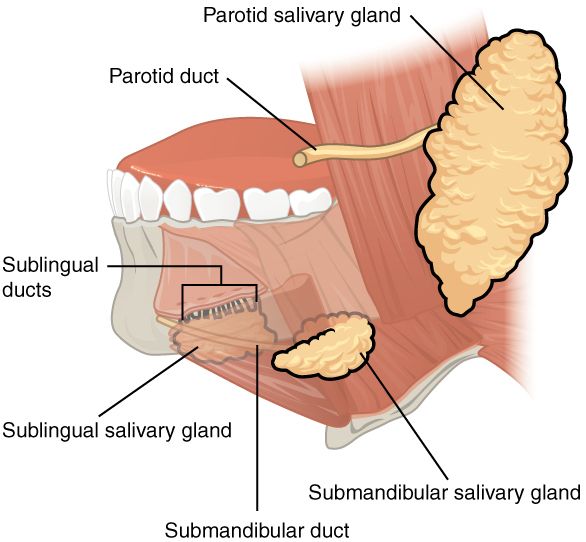
Diagram - Anatomy of the salivary glands
Creative commons source by OpenStax College [CC BY-SA 4.0 (https://creativecommons.org/licenses/by-sa/4.0)]
Sialolithiasis is the formation of a stone within the duct or parenchyma of a salivary gland. The submandibular glands are most commonly affected. The underlying cause is generally linked to reduced salivary flow, such as in dehydration or Sjogren’s syndrome. Salivary gland stones can present with a unilateral facial swelling and pain on eating. The stone may be palpable or even visible on examination. Diagnosis is with history, x-rays and ultrasound. The majority of cases are treated conservatively with oral fluids and analgesia, although some cases may require surgery.
The pharynx is a proximal part of the alimentary canal situated posterior to the oral and nasal cavities. It is an important structure as it provides a passage for air into the larynx and food into the oesophagus. It is important that these pathways do not get mixed up!
The pharynx is divided into 3 parts:
- Nasopharynx – situated posterior to the nasal cavity at the level of C1. The adenoids are located here. It also communicates with the middle ear via the Eustachian tube.
- Oropharynx – situated posterior to the oral cavity at the level of C2-3, extending from the soft palate to the epiglottis. It is a common route for both air and food.
- Laryngopharynx – situated posterior to the larynx at the level of C3-6, extending from the epiglottis to the oesophagus.
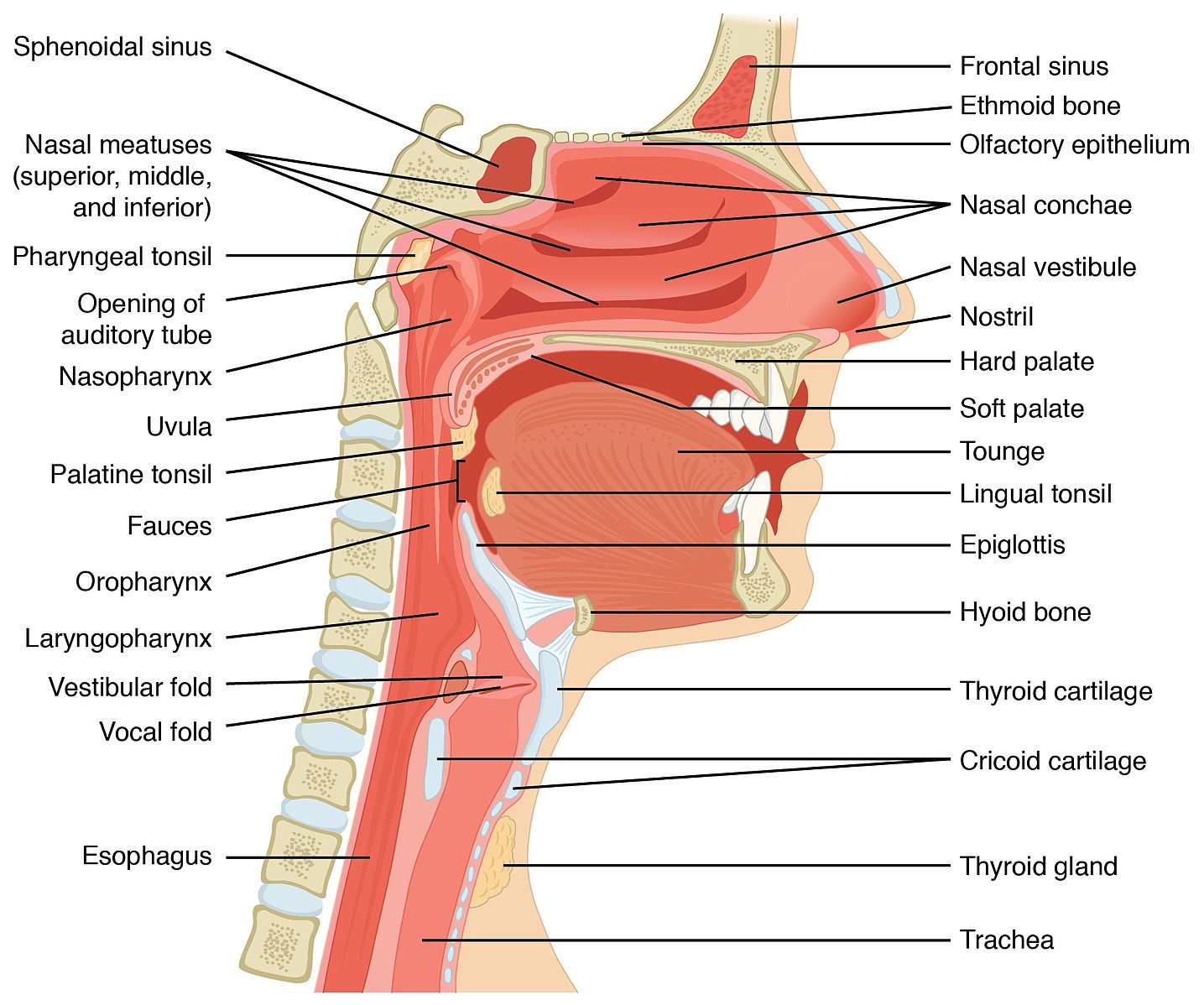
Diagram - Sagittal section of the head and neck, showing the anatomy of the pharynx and nearby structures
Creative commons source by OpenStax College [CC BY-SA 4.0 (https://creativecommons.org/licenses/by-sa/4.0)]
The muscles of the pharynx are grouped into longitudinal and circular:
- Longitudinal Muscles – these elevate the larynx during swallowing.
- Stylopharyngeus
- Palatopharyngeus
- Salpingopharyngeus
- Circular Muscles (Pharyngeal Constrictors) – these push material down the pharynx via peristalsis.
- Superior
- Middle
- Inferior
The inferior pharyngeal constrictor contains a weakness known as Killian’s dehiscence. Abnormal coordination of swallowing can cause the pharynx to herniate through this weakness, resulting in a pharyngeal pouch (or Zenker’s diverticulum). This presents with dysphagia, choking, regurgitation and halitosis (foul-smelling breath). Occasionally a lump may be palpable in the posterior midline of the neck. Treatment is with surgery.
In terms of motor innervation, most of the pharyngeal muscles are innervated by the vagus nerve (CN X). The exception is stylopharyngeus, which is innervated by the glossopharyngeal nerve (CN IX).
The sensory innervation of the pharynx is as follows:
- Nasopharynx – maxillary division of the trigeminal nerve (CN Vb)
- Oropharynx – glossopharyngeal nerve (CN IX)
- Laryngopharynx – vagus nerve (CN X)
Swallowing is a complex mechanism involving highly coordinated movements of the skeletal muscle of the tongue, soft palate, pharyngeal and laryngeal muscles.
The swallow is split into 3 phases:
- Oral Phase – the process of mastication produces a food bolus. The tongue then presses against the roof of the mouth and pushes the bolus towards the oropharynx. This phase is under voluntary control.
- Pharyngeal Phase – once the bolus reaches the pharynx, the swallowing reflex is stimulated and the rest of the swallow is under autonomic (involuntary) control. During this phase, the actions of many muscles ensure that food is pushed into the oesophagus whilst also protecting the airway.
- The soft palate is elevated to seal of the nasopharynx.
- The larynx is elevated via contraction of the suprahyoids and longitudinal pharyngeal muscles.
- The epiglottis closes over the laryngeal inlet due to elevation of the hyoid bone.
- The vocal cords adduct to close off the glottis.
- The pharyngeal constrictors contract and the upper oesophageal sphincter (UOS) relaxes to allow food to enter the oesophagus.
- Oesophageal Phase – once the bolus has entered the oesophagus, it is pushed down the oesophagus via peristalsis.
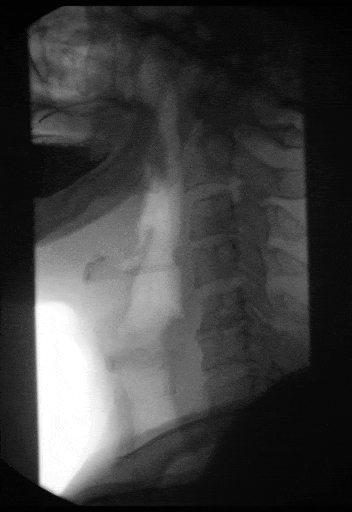
GIF - Barium swallow showing a normal swallowing reflex
Creative commons source by Hellerhoff, modified by Anka Friedrich [CC BY-SA 4.0 (https://creativecommons.org/licenses/by-sa/4.0)]
Lesions affecting cranial nerves V, VII and IX will result in sensory loss in their respective nerve territories.
A lesion affecting the vagus nerve (CN X) will paralyse the ipsilateral soft palate. When the patient is asked to ‘say aaaah’, their will be failure of the ipsilateral soft palate to rise and deviation of the uvula away from the side of the lesion. As the vagus nerve also supplies most of the pharyngeal muscles, the swallowing reflex may also be affected.
A lesion affecting the hypoglossal nerve (CN XII) will paralyse the ipsilateral skeletal muscle of the tongue. Therefore, when the patient is asked to protrude their tongue, the tongue will deviate towards the side of the lesion (to ‘lick the wound’). Muscle wasting and fasciculations may also be evident.
Reviewed by: Dr. Thomas Burnell
- 5495

